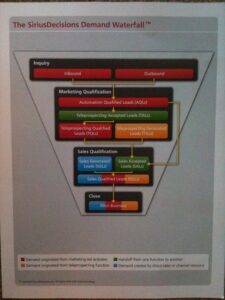Yesterday in the 106 degree Arizona weather, we received a needed waterfall – SiriusDecisions unveiled their upgraded view of the latest demand waterfall model at their annual conference. With an array of color codes and arrows, the new direction is spot as it accounts for revenue sourcing across all elements of the business rather than taking a more myopic view of just what marketing does for the business for net new revenue. It is no longer the ‘marketing waterfall’ but the ‘business waterfall’ in the 2.0 approach.
Here are my views of the new structure and why it is positive:
- At an executive level, one should be measuring the velocity and cost of the source of leads converting to new revenue, regardless of the source (inbound, outbound, teleprospecting, sales). According to Adobe’s 2012 CMO report, fewer than 20% measure their ROI on marketing, this framework will help contribute to defining the ROI element.
- At a more tactical inquiry level, a senior marketer needs to make a more intentional decision around resource allocation across inbound and outbound marketing mix and tactics. When the demand creation model was created 10 years ago, social media (LinkedIn as an example) was less prevalent than that of today).
- The model highlights the importance of the teleprospecting function in accepting, qualifying leads, and generating leads – this function’s importance is often underestimated or routinely outsourced without thinking through strategic revenue implications. (See previous post here). It’s the toughest job in the business in my opinion. By explicitly calling out outbound teleprospecting accountability, a key skillset for account executives, sales leaders should welcome this new framework as it also spells out a clearer career path for teleprospectors.
- Within the marketing qualification step, by putting more accountability within teleprospecting to ‘accept’ the leads rather than work all leads by marketing, the chances of marketing dumping several unqualified leads onto sales is further reduced.
There are nuances depending on the type of business that the model may need to be tweaked for – specifically around channel partners or other 3rd party mechanisms that generate revenue though the idea and flow should largely be the same. Also, what’s not discussed is how to implement this kind of waterfall depending on the current stage of current processes – it will take an organization a committed period of time, so phasing and testing should be key to implementation. Lastly, I’ve surprisingly found a number of organizations, particularly larger ones, dancing around the conversation of ‘sourced’ vs. ‘influenced’ revenue, with some larger companies driving in one direction or the other rather than looking at both. As SAP CMO @jbecher tweeted from the audience yesterday, ‘culture eats strategy’. Specifically, one needs to be aware of the rigor and thoroughness this model represents and the willingness of the company to absorb the model.
It is critical for companies to do this kind of measuring to improve performance. It is the right thing to do.
What are your views of the model?

